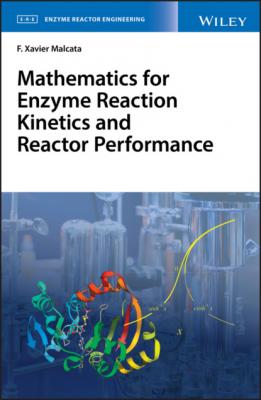Mathematics for Enzyme Reaction Kinetics and Reactor Performance. F. Xavier Malcata
Читать онлайн.| Название | Mathematics for Enzyme Reaction Kinetics and Reactor Performance |
|---|---|
| Автор произведения | F. Xavier Malcata |
| Жанр | Химия |
| Серия | |
| Издательство | Химия |
| Год выпуска | 0 |
| isbn | 9781119490333 |
– as outlined in Fig. 2.10a, also at the expense of Eq. (2.287); one may rewrite Eq. (2.307) as
after taking the reciprocal of the reciprocal, in view of Eq. (2.288). Once θ is expressed in rad, Eq. (2.308) becomes
– as illustrated in Fig. 2.10c. Since this function repeats itself every 2π rad, i.e.
(2.310)
it can be claimed as periodic; furthermore, its definition as per Eq. (2.309) entails
(2.311)
with the aid of Eq. (2.296), so the secant is an even function and thus symmetrical with regard to the vertical axis. The secant is not a monotonic function; it decreases and then increases within](2k − 1)π/2,(2k + 1)π/2[ for even integer k, with vertical asymptotes at the extremes, or vice versa with odd integer k.
Finally, the cosecant of angle θ is given by the ratio of the length of the hypotenuse, [OB], to the length of the opposite leg, [AB], in triangle [OAB] – or, equivalently, as the secant of the complementary angle of θ, i.e. the ratio of the length of the hypotenuse, [OE], to the length of the adjacent leg, [OB], in triangle [OBE], i.e.
that incorporates Eq. (2.287) – as depicted in Fig. 2.10 a; therefore, Eq. (2.312) may be reformulated to read
upon taking the reciprocal of the reciprocal, owing to Eq. (2.290). For θ expressed in rad, Eq. (2.313) will in general look like
– as plotted in Fig. 2.10d. A period of 2π rad is again found, viz.
(2.315)
in addition, Eq. (2.314) has it that
(2.316)
with the aid of Eq. (2.295), should the argument be replaced by its negative – so the cosecant is symmetrical with regard to the origin of the axes, as per its odd behavior. Note that the cosecant increases and then decreases within](2k − 1)π,2kπ[ for integer k, bounded by vertical asymptotes described by x = (2k − 1)π and x = 2kπ, respectively, and the other way round within]2kπ,(2k + 1)π[.
2.3.2 Angle Transformation Formulae
Referring again to Fig. 2.10a, one may label as u1 the unit vector centered at the origin, defining an angle θ1 with the horizontal axis – with coordinates (cos θ1, sin θ1) as per Eqs. (2.288) and (2.290); and likewise as u2 the unit vector centered at O but defining an angle θ2 – with coordinates (cos θ2, sin θ2), with θ2 > θ1 for simplicity. Under these circumstances, the scalar product of u1 and u2 (to be discussed later) reads
as per its defining algorithm, and because ‖ u1‖ = ‖ u2‖ = 1 by hypothesis; Eq. (2.317) readily simplifies to
where θ2 − θ1 > 0 represents the amplitude of the angle defined by vectors u1 and u2, i.e. ∠ u1, u2. As will be duly proven below, u1 · u2 may instead be calculated via
so elimination of u1· u2 between Eqs. (2.318) and (2.319) unfolds
this is equivalent to
